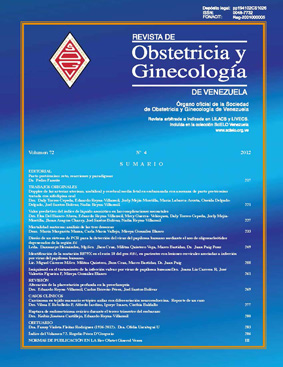Infección genital por ureaplasma urealyticum en mujeres infértiles
Palabras clave:
Infección Genital, Infertilidad, Ureaplasma Urealyticum, Genital Infection, InfertilityResumen
Determinar la prevalencia de la infección genital por Ureaplasma urealyticum en mujeres infértiles atendidas en una clínica de fertilidad privada de Maracaibo, Estado Zulia. Métodos: Investigación descriptiva, con diseño de tipo no experimental y transeccional; en la cual se estudiaron 50 mujeres con diagnóstico de infertilidad, a las cuales se les tomó una muestra de hisopado endocervical para el diagnóstico de Ureaplasma urealyticum mediante reacción en cadena de la polimerasa. Resultados: Se encontró una prevalencia de infección genital por Ureaplasma urealyticum en mujeres infértiles de24 % (n= 12/50). Al indagar la causa de la infertilidad prevaleció la infertilidad secundaria (56 %; n= 28/50) y como causales, el factor ovulatorio (60 %) y el tubárico (36 %), las cuales referían la presencia de síntomas como leucorrea (32 %) o sangrado poscoital (16 %) y antecedentes de infección por virus del papiloma humano (32 %). Asimismo, se encontró una asociación significativa entre la presencia de síntomas clínicos y antecedentes ginecológicos con el diagnóstico de infección genital por Ureaplasma urealyticum (p = 0,047). Conclusión: Ureaplasma urealyticum es un microorganismo prevalente en mujeres infértiles, el cual se asocia significativamente con los síntomas y antecedentes clínicos, por lo que se recomienda su pesquisa dentro del manejo de la pareja infértil.
To determine the prevalence of genital infection with Ureaplasma urealyticum in infertile women attending at a private fertility clinic in Maracaibo, Zulia State. Methods: Descriptive research, with non-experimental and transectional design; in which 50 women diagnosed with infertility were studied, who were taken an endocervical swab sample for the diagnosis of Ureaplasma urealyticum by polymerase chain reaction. Results: A prevalence of 24% (n = 12/50) of genital infection in infertile women by Ureaplasma urealyticum was found. When investigating the cause of infertility, they prevailed women with secondary infertility (56%; n = 28/50) and as causal ovulatory (60%) and tubal factor (36%); which concerned the presence of symptoms such as leukorrhea (32%) or postcoital bleeding (16%) and a history of infection by the human papillomavirus (32%). Also, a significant association between the presence of clinical symptoms and gynaecological history with the diagnosis of genital infection Ureaplasma urealyticum (p = 0.047) was found. Conclusion: Ureaplasma urealyticum is a microorganism prevalent in infertile women, which is significantly associated with symptoms and clinical history, so it is recommended to research into the management of the infertile couple.

